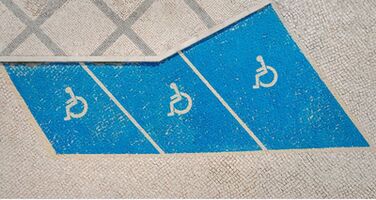
Tips for Displaying Your Disability Tag Correctly in Vermont
For individuals with disabilities, a disability tag, or handicap placard, is essential for accessing accessible parking spaces in VT. Knowing how to display your disability tag correctly ensures that you can park without issues and avoid fines. In VT, these tags grant access to convenient parking options, providing a shorter distance to entrances and exits in public spaces. However, displaying the tag incorrectly can lead to misunderstandings or even fines. This article provides essential tips for correctly displaying your handicap placard in Vermont, offering insights into the specific requirements and addressing common questions.
Understanding Handicap Placards in Vermont
Disability tags, also known as placards, are issued by the state Department of Motor Vehicles (DMV) to individuals with medically certified disabilities. These tags allow users to park in designated accessible handicap parking spaces close to buildings, providing convenience and reducing the physical strain of walking longer distances.
Types of Disability Tags in VT
In VT, there are two primary types of handicap permits:
- Permanent Tags: Issued to individuals with long-term or permanent disabilities. They are valid for multiple years but must be renewed every four years.
- Temporary Tags: Designed for individuals with temporary disabilities, such as a broken leg or recovery from surgery. These are usually valid for up to six months, depending on the condition.
- Disability License Plates: Permanently affixed to a vehicle for those who require ongoing accessibility parking.
Each type has its own display and usage rules, making it essential to understand how to handle and show the tag correctly.
Eligibility Criteria for Disabled Permits in Vermont
To qualify for a Vermont handicap placard, individuals must have a medical condition that significantly restricts their mobility or physical functioning. The state has specific eligibility criteria to ensure that the permits are issued only to those who truly need them.
Common Eligibility Requirements:
- Inability to walk more than 200 feet without stopping to rest.
- Severe lung disease limiting mobility.
- Use of portable oxygen for respiratory support.
- Cardiac conditions classified as Class III or IV by the American Heart Association.
- Severe physical limitations due to orthopedic, neurological, or arthritic conditions.
- Legally blind individuals or those with significant visual impairments.
Medical Certification: To confirm eligibility, a licensed healthcare professional must certify that the individual meets one or more of the above conditions. This certification is part of the application process for obtaining a disability tag.
How to Apply for a Handicap Placad in Vermont
1. Obtain the Application Form: Theapplication form for a disability placard or license plate can be found on the state's DMV website or picked up in person at a local DMV office.
2. Fill Out Personal Information: Complete the required sections of the application form, including personal details like name, address, and contact information.
3. Have Your Medical Certification Completed: A licensed HandicapMD healthcare professional must fill out the medical certification section of the application, verifying that you meet the state’s eligibility criteria.
4. Submit the Application:
- In-person: Visit your local DMV office to submit the form.
- By mail: Send the completed form to:
- Vermont Department of Motor Vehicles
120 State Street
Montpelier, VT 05603-0001
- Vermont Department of Motor Vehicles
5. Pay Applicable Fees: Temporary and permanent tags are typically issued without a fee, but there may be a charge for disability license plates. Check with the state's DMV for the latest fee schedule.
6. Processing Time: Applications are generally processed within a few weeks, but processing times can vary depending on the volume of applications.
How to Replace or Renew a Disability Tag in Vermont
Replacement Process for Lost or Stolen Tags:
- Report the Loss: Notify the state's DMV and, if necessary, local authorities if you believe the tag was stolen.
- Complete a Replacement Application: Fill out the appropriate form from the state's DMV website or office.
- Submit the Application: Send the completed form, along with any required documentation, either in person or by mail.
- Pay Any Fees: Be prepared to pay a small fee for processing.
Renewal Process for Permanent Tags:
- Check Expiration: Make note of your tag’s expiration date and keep an eye out for renewal notices from the state's DMV.
- Complete Renewal Application: If required, fill out a renewal form and ensure your medical certification is up to date if requested.
- Submit Your Application: Send the renewal application to the state's DMV before the expiration date to avoid a lapse in your parking privileges.
Temporary Tag Renewal: Temporary tags cannot be renewed. If your medical condition requires extended use, you must submit a new application with updated medical information.
Importance of Correct Display of Disabled Permits
Displaying a disability tag correctly in VT is crucial for several reasons:
- Ensures Access to Designated Parking: Proper display allows you to access accessible parking spaces without facing issues or fines.
- Avoids Parking Violations: Incorrectly displayed tags can result in fines or warnings from parking authorities, as your tag must be visible at all times.
- Reduces Risk of Misuse: Proper display minimizes the likelihood of misuse by others who might attempt to use your tag unlawfully.
Top Tips for Displaying Your Handicap Placard in Vermont
Here are some best practices to ensure your handicap placard is displayed correctly and complies with state regulations:
1. Hang the Tag from the Rearview Mirror
- Correct Placement: When parked, your disability tag should be hung from the rearview mirror so that it is visible through the front windshield. This allows parking attendants or law enforcement officers to easily identify the tag and verify your eligibility.
- Avoid Obstruction: Make sure the tag does not block your view while driving. Remove the tag from the rearview mirror before starting your vehicle to comply with the state's traffic safety laws.
2. Ensure the Front Side Faces Outward
- Visibility Matters: The side of the tag displaying the expiration date and unique identification number should face outward so that it is readable from outside the vehicle. This helps officials confirm the validity of the tag without needing to inspect it closely.
3. Check for Proper Expiration Date Display
- Regularly Inspect Your Tag: Keep track of the expiration date on your tag and make sure it is still valid. Using an expired tag, even by mistake, can lead to fines or having your tag revoked.
- Renewal Reminders: Consider setting reminders to renew your tag before it expires. VT’s Department of Motor Vehicles (DMV) typically sends renewal notices for permanent tags, but it’s helpful to set a personal reminder as well.
4. Keep the Tag Clean and Legible
- Avoid Damage: Keep your disability tag in a safe location when not in use to prevent it from becoming dirty or damaged. A worn-out tag can be difficult to read and may result in misunderstandings with parking enforcement.
- Cleaning Tips: Use a soft, damp cloth to clean the tag occasionally, making sure not to scratch or smudge important details like the expiration date or ID number.
5. Remove the Tag When Driving
- Safety First: The state law requires that drivers remove their disability tags from the rearview mirror when the vehicle is in motion. A hanging tag can obstruct your view and become a safety hazard. Always remove the tag and store it securely when you’re driving.
- Storage Solutions: Keep a designated spot in your vehicle, such as the glove compartment or a storage pocket, where you can place your tag when not in use.
6. Use the Tag Only When Necessary
- Compliance with Regulations: The tag should only be used when the person it was issued to is either driving or a passenger in the vehicle. Using the tag without the rightful holder present is considered misuse and can lead to penalties, including fines or the revocation of the tag.
- Authorized Use: Ensure that family members or caregivers know that the tag must only be used when the qualified individual is in the vehicle.
Common Mistakes to Avoid
1. Leaving the Tag Hanging While Driving: One of the most common mistakes is leaving the tag hanging from the rearview mirror while driving. This practice not only obstructs your view but also violates VT’s safety regulations. Always remove the tag before starting your car.
2. Using an Expired Tag: Driving with an expired tag can lead to fines and the potential loss of parking privileges. Always check the expiration date and renew your tag on time.
3. Placing the Tag Incorrectly: If the tag is not hung from the rearview mirror or if it is placed in a less visible area, enforcement officers may not see it, and you could receive a ticket. Make sure the tag is visible and facing outward.
4. Allowing Unauthorized Use: Lending your tag to someone who is not eligible for it, even if they are running errands for you, is illegal. This type of misuse is taken seriously and can result in the suspension of your tag.
5. Failing to Report a Lost or Stolen TagIf your tag is lost or stolen, report it to the state's DMV immediately. Using a stolen or counterfeit tag is a criminal offense that can carry serious consequences.
Best Practices for Disability Tag Care
1. Use a Protective CoverA protective cover can help prevent your tag from getting scratched or damaged. It’s an inexpensive way to keep it in good condition and extend its lifespan.
2. Store the Tag in a Safe PlaceWhen not in use, store the tag in a designated area within your vehicle, such as a glove compartment or side pocket. This helps prevent damage and makes it easy to find when needed.
3. Keep Copies of Important DocumentsIt’s a good idea to keep a copy of your original tag application or medical certification, especially if you travel frequently. This can be useful if your tag is lost or stolen, or if questions arise about your eligibility while using accessible parking in another state.
4. Educate Family Members and CaregiversIf others frequently drive you, make sure they understand how to properly use and display your disability tag. Inform them about VT’s rules and the importance of compliance to avoid unintentional misuse.
Where You Can and Cannot Park with a Disability Tag
While a disability tag grants access to accessible parking spaces, it does not authorize parking in other restricted areas. With a valid disability tag, you can:
- Park in designated accessible spots: These are typically marked by blue signage and pavement markings.
- Park in metered spaces without payment: Some municipalities in VT allow disability tag holders to park at meters without paying.
However, a disability tag does not permit parking:
- In loading zones or fire lanes
- In spaces designated for emergency vehicles
- In no-parking zones or areas marked as reserved for specific purposes, like reserved spaces for doctors or school buses.
How to Avoid Tag Theft and Misuse
To keep your tag secure:
- Remove it when not in use: Keeping the tag out of sight when you’re not parked in an accessible space helps prevent theft.
- Store it in a secure location: A locked glove compartment or a dedicated storage case can protect it from unauthorized access.
- Stay vigilant: Avoid sharing your tag with others and report any instances of suspected misuse.
What to Do If You’re Ticketed Despite Correct Display
If you receive a ticket despite correctly displaying your disability tag:
- Review the Ticket Details: Sometimes, mistakes occur, and details like the vehicle make or location may be incorrect.
- Collect Evidence: Take photos of the properly displayed tag, including its position and visibility at the time of parking.
- Contact Local Authorities: Reach out to the issuing agency, providing evidence that the tag was displayed correctly. In most cases, tickets issued by mistake can be waived.
Using Temporary Tags in Vermont
Temporary disability tags are issued for short-term needs and have specific expiration dates. For temporary tags, display rules are the same as for permanent tags, but always check the expiration date to ensure compliance. If additional time is needed, consult a licensed HandicapMD healthcare provider and the state's DMV about renewing or reapplying.
Additional Accessibility Resources for VT Residents
VT offers several resources for residents with disabilities, including:
- Accessible transportation services: Many cities provide accessible public transport options for people with disabilities.
- Online DMV Services: The Vermont DMV provides several online options to help residents apply for, renew, or replace disability tags.
- Local Assistance Programs: Various nonprofits and support agencies help individuals with disabilities access parking, transportation, and other essential services.
Understanding Fines for Misuse or Incorrect Display
Misuse or incorrect display of a disability tag can lead to fines, with penalties varying based on the violation. Common fines include:
- Using a tag without the eligible individual present: Strictly prohibited and can result in steep penalties.
- Parking in a restricted area: Even with a disability tag, unauthorized parking in restricted zones can lead to fines.
- Failure to renew on time: Expired tags should be renewed to avoid penalties and ensure parking privileges remain intact.
How to Appeal Parking Violations Related to Disability Tags
If you receive a ticket related to the use of your disability tag, you may appeal it by following these steps:
- Gather Evidence: Document the correct display of your tag.
- Complete the Appeal Form: Obtain the appropriate form from the issuing agency or parking authority and include any relevant information.
- Submit Proof of Validity: A valid disability tag along with medical certification, if required, can support your appeal.
- Attend a Hearing (if necessary): In some cases, a hearing may be required to resolve disputes.
Appeals are often successful if the evidence confirms that the disability tag was used correctly and in compliance with the state laws.
FAQs About Displaying Disability Tags in VT
Q1: Can I leave my disability tag on the rearview mirror while driving?
No, VT law requires you to remove the tag while driving to avoid obstructing your view.
Q2: What should I do if my disability tag is stolen?
Report the theft to the state's DMV and apply for a replacement as soon as possible.
Q3: Can I let a family member use my tag if they’re running an errand for me?
No, the disability tag is only for use when the eligible individual is present in the vehicle. Misuse may lead to fines or revocation.
Q4: Do I need to renew my disability tag?
Yes, permanent tags in VT must be renewed every four years, while temporary tags typically expire after six months.
Q5: Can I park for free at metered spaces with a disability tag?
Some municipalities in VT offer free parking at meters for disability tag holders, but it’s essential to check with local regulations.
Q6: What do I do if I receive a ticket even though my tag was displayed correctly?
Document the correct display, including photos, and appeal the ticket with the issuing agency. Most authorities will dismiss tickets if the tag was displayed in compliance with state guidelines.
Conclusion: Ensuring Access and Compliance
Correctly displaying your handicap placard in Vermont is essential for ensuring accessibility and avoiding fines. Following the tips in this article will help you maintain compliance with VT’s regulations, allowing you to utilize accessible parking spaces without any issues. Remember to check your tag regularly, keep it stored securely, and follow all renewal requirements. By taking these steps, you’ll ensure uninterrupted access to convenient parking options and a smoother experience wherever you go.
Remember, misuse of a disability tag can result in serious consequences, so it’s vital to understand and adhere to the rules. Whether you’re parking at your local grocery store, visiting a doctor’s office, or traveling out of state, taking the time to display your tag correctly makes your experience safer and smoother.
With the right knowledge and responsible practices, using your disability tag in VT can provide the ease and accessibility you need to go about your daily life with confidence.
.png)






